ECU TOYOTA COROLLA 2010 10.G Owners Manual
[x] Cancel search | Manufacturer: TOYOTA, Model Year: 2010, Model line: COROLLA, Model: TOYOTA COROLLA 2010 10.GPages: 476, PDF Size: 9.5 MB
Page 3 of 476
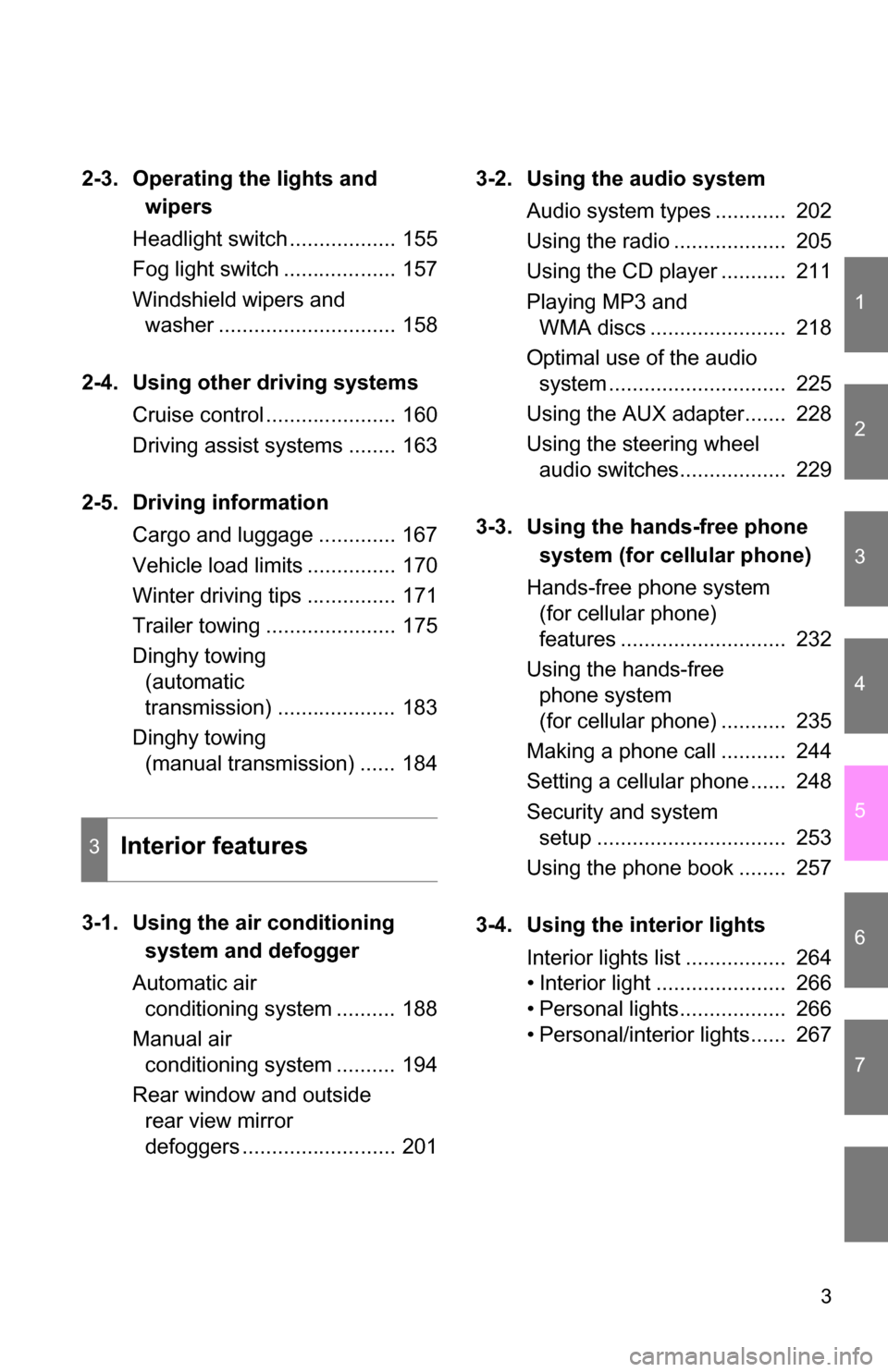
1
2
3
4
5
6
7
3
2-3. Operating the lights and wipers
Headlight switch .................. 155
Fog light switch ................... 157
Windshield wipers and washer .............................. 158
2-4. Using other driving systems Cruise control ...................... 160
Driving assist systems ........ 163
2-5. Driving information Cargo and luggage ............. 167
Vehicle load limits ............... 170
Winter driving tips ............... 171
Trailer towing ...................... 175
Dinghy towing (automatic
transmission) .................... 183
Dinghy towing (manual transmission) ...... 184
3-1. Using the air conditioning system and defogger
Automatic air conditioning system .......... 188
Manual air conditioning system .......... 194
Rear window and outside rear view mirror
defoggers .......................... 201 3-2. Using the audio system
Audio system types ............ 202
Using the radio ................... 205
Using the CD player ........... 211
Playing MP3 and WMA discs ....................... 218
Optimal use of the audio system .............................. 225
Using the AUX adapter....... 228
Using the steering wheel audio switches.................. 229
3-3. Using the hands-free phone system (for cellular phone)
Hands-free phone system (for cellular phone)
features ............................ 232
Using the hands-free phone system
(for cellular phone) ........... 235
Making a phone call ........... 244
Setting a cellular phone ...... 248
Security and system setup ................................ 253
Using the phone book ........ 257
3-4. Using the interior lights Interior lights list ................. 264
• Interior light ...................... 266
• Personal lights.................. 266
• Personal/interior lights...... 267
3Interior features
Page 11 of 476
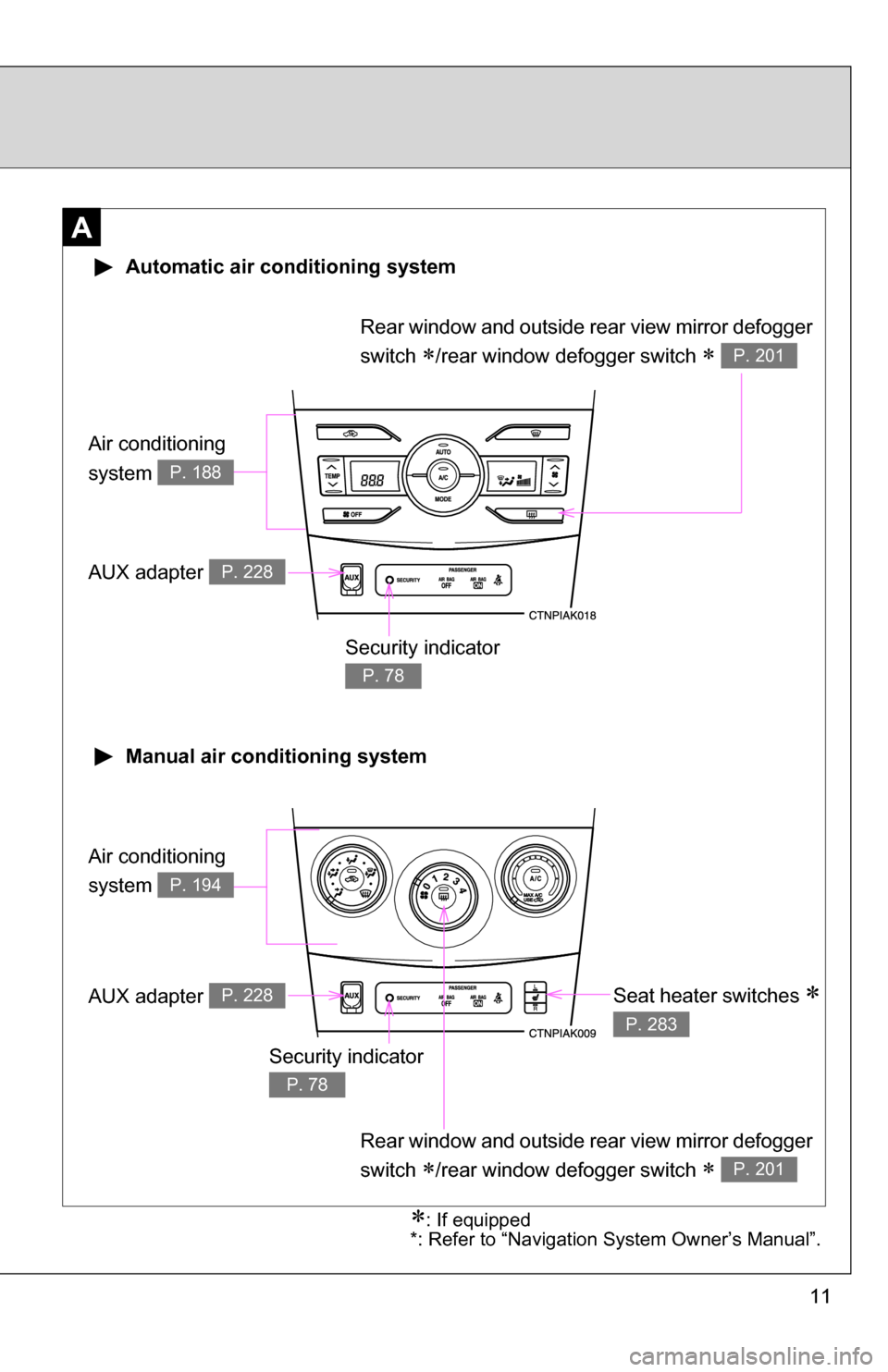
11
A
Air conditioning
system
P. 188
Air conditioning
system
P. 194
Automatic air conditioning system
Manual air conditioning system
Security indicator
P. 78
Seat heater switches
P. 283
AUX adapter P. 228
AUX adapter P. 228
: If equipped
*: Refer to “Navigation System Owner’s Manual”.
Rear window and outside rear view mirror defogger
switch
/rear window defogger switch P. 201
Rear window and outside rear view mirror defogger
switch
/rear window defogger switch P. 201
Security indicator
P. 78
Page 30 of 476
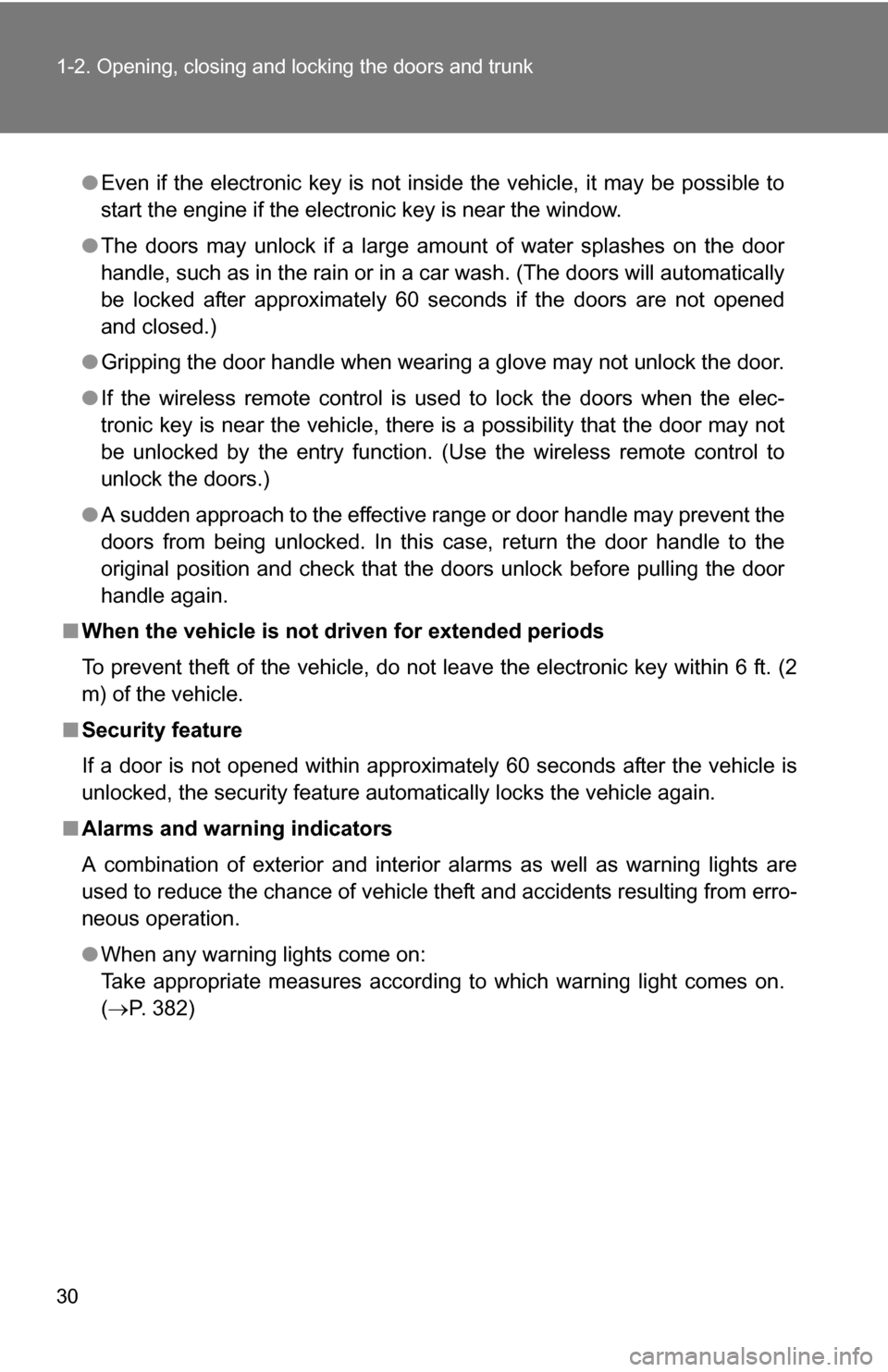
30 1-2. Opening, closing and locking the doors and trunk
●Even if the electronic key is not inside the vehicle, it may be possible to
start the engine if the electronic key is near the window.
● The doors may unlock if a large amount of water splashes on the door
handle, such as in the rain or in a car wash. (The doors will automatically
be locked after approximately 60 seconds if the doors are not opened
and closed.)
● Gripping the door handle when wearing a glove may not unlock the door.
● If the wireless remote control is used to lock the doors when the elec-
tronic key is near the vehicle, there is a possibility that the door may not
be unlocked by the entry function. (Use the wireless remote control to
unlock the doors.)
● A sudden approach to the effective range or door handle may prevent the
doors from being unlocked. In this case, return the door handle to the
original position and check that the doors unlock before pulling the door
handle again.
■ When the vehicle is not driven for extended periods
To prevent theft of the vehicle, do not leave the electronic key within 6 ft. (2
m) of the vehicle.
■ Security feature
If a door is not opened within approximately 60 seconds after the vehicle is
unlocked, the security feature automatically locks the vehicle again.
■ Alarms and warning indicators
A combination of exterior and interior alarms as well as warning lights are
used to reduce the chance of vehicle theft and accidents resulting from erro-
neous operation.
●When any warning lights come on:
Take appropriate measures according to which warning light comes on.
( P. 382)
Page 37 of 476

37
1-2. Opening, closing and locking the doors and trunk
1
Before driving
■
Key battery depletion
Vehicles with smart key system
P. 2 9
Vehicles without smart key system
If the wireless remote control function does not operate, the battery may be
depleted. Replace the battery when necessary. ( P. 347)
■ Security feature
If a door is not opened within approximately 60 seconds after the vehicle is
unlocked, the security feature automatically locks the vehicle again.
■ When the electronic key battery is fully depleted (vehicles with smart
key system)
P. 346
■ Conditions affecting operation
Vehicles with smart key system
P. 2 7
Vehicles without smart key system
The wireless remote control function may not operate normally in the follow-
ing situations.
● Near a TV tower, radio station, electr ic power plant, airport or other facil-
ity that generates strong radio waves
● When carrying a portable radio, cell ular phone or other wireless commu-
nication devices
● When multiple wireless keys are in the vicinity
● When the wireless key has come into contact with, or is covered by, a
metallic object
● When a wireless key (that emits radio waves) is being used nearby
● When the wireless key has been left near an electrical appliance such as
a personal computer
● When the wireless key battery is depleted
● If window tint with a metallic content or metallic objects are attached to
the rear window
Page 53 of 476

53
1-3. Adjustable components (s
eats, mirrors, steering wheel)
1
Before driving
CAUTION
■After returning the seatback to the upright position
Observe the following precautions. Failure to do so may result in death or
serious injury.
●Make sure the seatback is securely locked by pressing forward and rear-
ward on the top of the seatback.
● Check that the seat belts are not twisted or caught in the seatback.
NOTICE
■When a rear seatback is folded down
●Make sure the luggage loaded in the enlarged trunk will not damage the
webbing of the rear center seat belt.
● Do not hold the seat by the seat belt comfort guide to prevent damage to
the rear seat.
Page 60 of 476
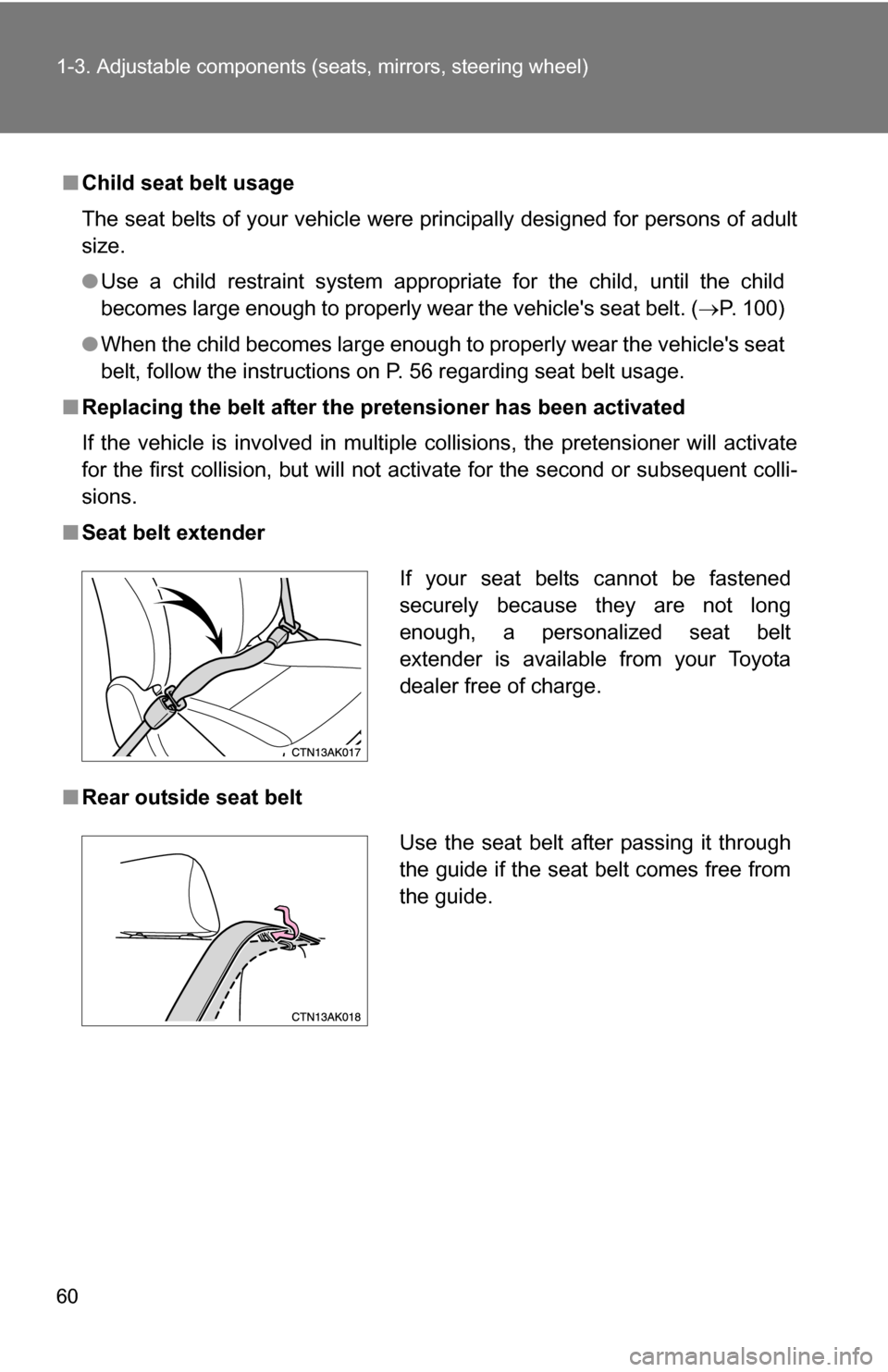
60 1-3. Adjustable components (seats, mirrors, steering wheel)
■Child seat belt usage
The seat belts of your vehicle were principally designed for persons of adult
size.
●Use a child restraint system appropriate for the child, until the child
becomes large enough to properly wear the vehicle's seat belt. ( P. 100)
● When the child becomes large enough to properly wear the vehicle's seat
belt, follow the instructions on P. 56 regarding seat belt usage.
■ Replacing the belt after the pretensioner has been activated
If the vehicle is involved in multiple collisions, the pretensioner will activate
for the first collision, but will not activate for the second or subsequent colli-
sions.
■ Seat belt extender
■ Rear outside seat belt
If your seat belts cannot be fastened
securely because they are not long
enough, a personalized seat belt
extender is available from your Toyota
dealer free of charge.
Use the seat belt after passing it through
the guide if the seat belt comes free from
the guide.
Page 63 of 476

63
1-3. Adjustable components (s
eats, mirrors, steering wheel)
1
Before driving
CAUTION
■Using a seat belt comfort guide
●Make sure the belt is not twisted and that it lies flat. The elastic cord must
be behind the belt and the guide must be on the front.
● To reduce the chance of injury in case of an accident or a sudden stop
while driving, remove and store the comfort guide in its pocket when it is
not in use.
● Always make sure the shoulder belt is positioned across the center of the
shoulder. The belt should be kept away from the neck, and should not fall
off the shoulder.
Failure to observe these precautions could reduce the effectiveness of the
seat belt in an accident, causing death or serious injury.
■ Using a seat belt extender
●Do not wear the seat belt extender if you can fasten the seat belt without
the extender.
● Do not use the seat belt extender when installing a child restraint system
because the belt will not securely hold the child restraint system, increas-
ing the risk of death or serious injury in the event of an accident.
● The personalized extender may not be safe on another vehicle, when
used by another person, or at a different seating position other than the
one originally intended.
NOTICE
■When using a seat belt extender
When releasing the seat belt, press on the buckle release button on the
extender, not on the seat belt.
This helps prevent damage to the vehicle interior and the extender itself.
Page 64 of 476
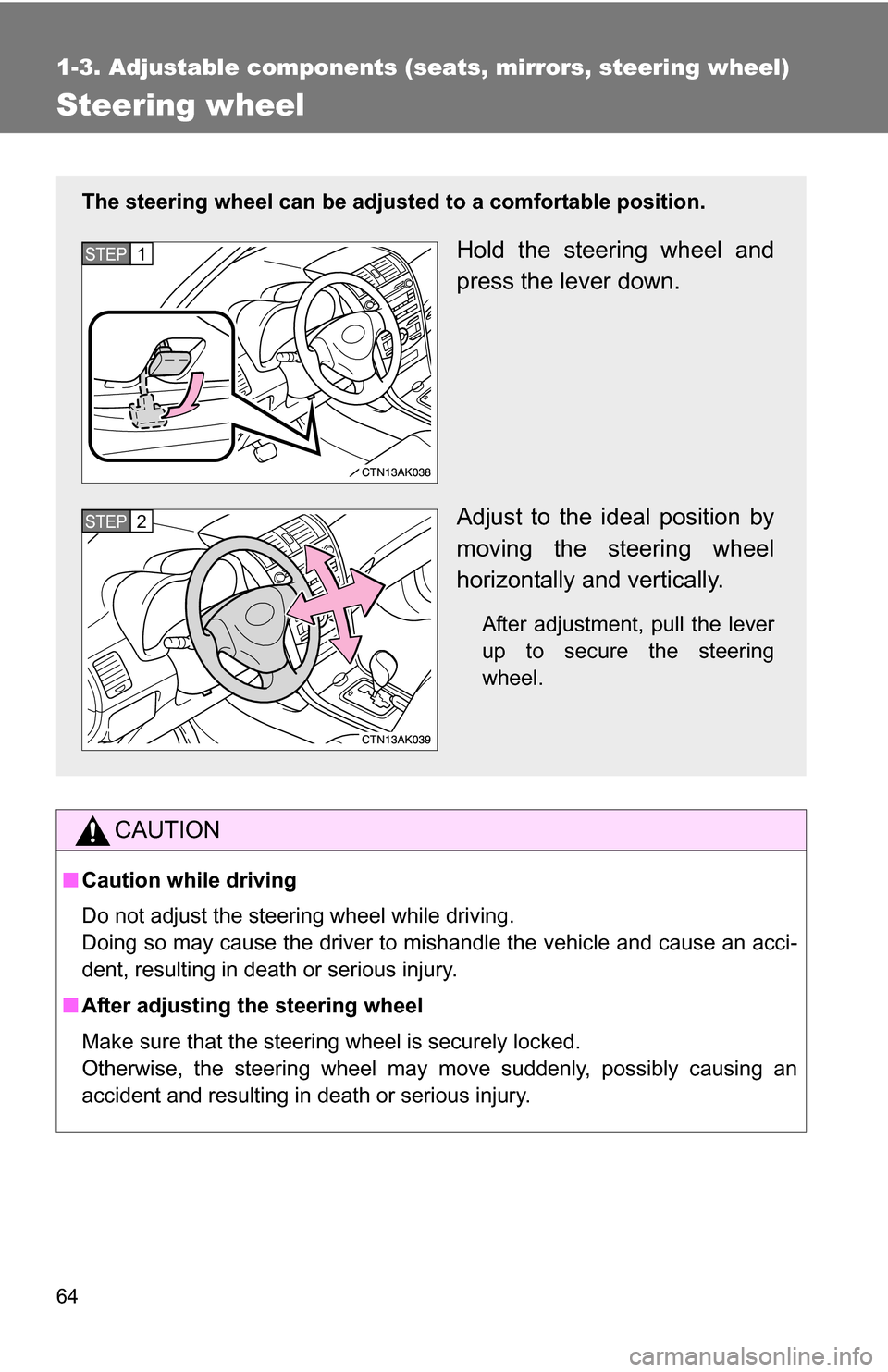
64
1-3. Adjustable components (seats, mirrors, steering wheel)
Steering wheel
CAUTION
■Caution while driving
Do not adjust the steering wheel while driving.
Doing so may cause the driver to mishandle the vehicle and cause an acci-
dent, resulting in death or serious injury.
■ After adjusting the steering wheel
Make sure that the steering wheel is securely locked.
Otherwise, the steering wheel may move suddenly, possibly causing an
accident and resulting in death or serious injury.
The steering wheel can be adjust ed to a comfortable position.
Hold the steering wheel and
press the lever down.
Adjust to the ideal position by
moving the steering wheel
horizontally and vertically.
After adjustment, pull the lever
up to secure the steering
wheel.
STEP 1
STEP 2
Page 78 of 476

78
1-6. Theft deterrent system
Engine immobilizer system
■System maintenance
The vehicle has a maintenance-free type of engine immobilizer system.
■ Conditions that may cause the system to malfunction
●If the key is in contact with a metallic object
● If the key is in close proximity to or touching a key to the security system
(key with a built-in transponder chip) of another vehicle
The vehicle's keys have built-in tran sponder chips that prevent the
engine from starting if the key has not been previously registered in
the vehicle's on-board computer.
Never leave the keys inside the vehicle when you leave the vehicle.
Vehicles with smart key sys-
tem: The indicator light flashes
after the “ENGINE START
STOP” switch has been turned
OFF to indicate that the sys-
tem is operating.
Vehicles without smart key
system: The indicator light
flashes after the key has been
removed from the engine
switch to indicate that the sys-
tem is operating.
Page 84 of 476
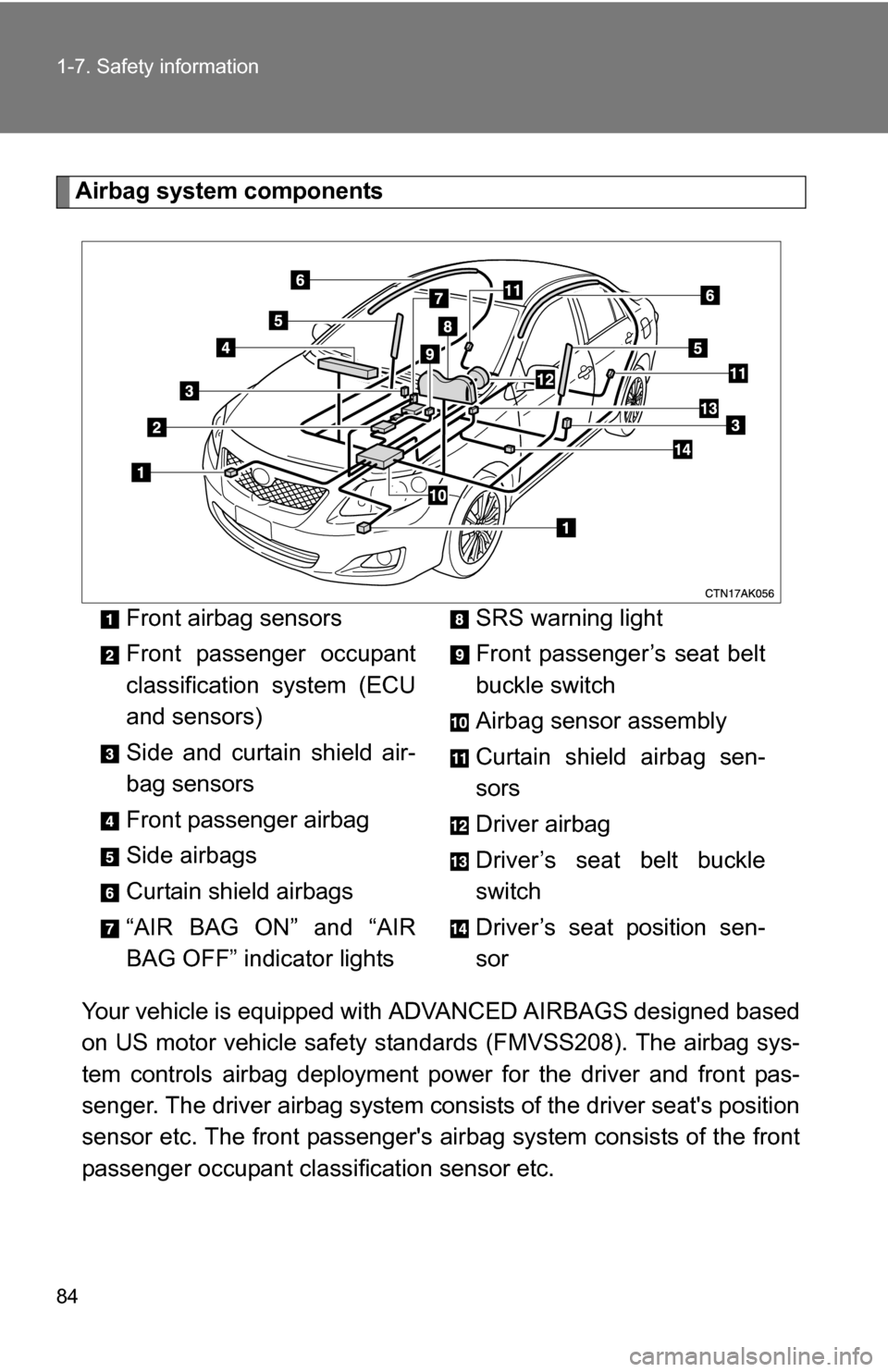
84 1-7. Safety information
Airbag system componentsYour vehicle is equipped with ADVANCED AIRBAGS designed based
on US motor vehicle safety standards (FMVSS208). The airbag sys-
tem controls airbag deployment po wer for the driver and front pas-
senger. The driver airbag system cons ists of the driver seat's position
sensor etc. The front passenger's airbag system consists of the front
passenger occupant classification sensor etc. Front airbag sensors
Front passenger occupant
classification system (ECU
and sensors)
Side and curtain shield air-
bag sensors
Front passenger airbag
Side airbags
Curtain shield airbags
“AIR BAG ON” and “AIR
BAG OFF” indicator lights
SRS warning light
Front passenger’s seat belt
buckle switch
Airbag sensor assembly
Curtain shield airbag sen-
sors
Driver airbag
Driver’s seat belt buckle
switch
Driver’s seat position sen-
sor